SUMMARY CMI
REVLIMID®
Consumer Medicine Information (CMI) summary
The full CMI on the next page has more details. If you are worried about using this medicine, speak to your doctor or pharmacist.
WARNING: Important safety information is provided in a boxed warning in the full CMI. Read before using this medicine.
1. Why am I using REVLIMID?
REVLIMID contains the active ingredient lenalidomide. REVLIMID is used to treat patients with Multiple Myeloma. REVLIMID is also used to treat patients who have conditions called myelodysplastic syndromes (MDS) in whom the bone marrow does not produce enough mature blood cells. REVLIMID is used to treat adult patients who have been diagnosed with and previously treated for Mantle Cell Lymphoma (MCL). For more information, see Section 1. Why am I using REVLIMID? in the full CMI.
2. What should I know before I use REVLIMID?
Do not use if you have ever had an allergic reaction to lenalidomide or any of the ingredients listed at the end of the CMI.
Talk to your doctor if you have any other medical conditions, take any other medicines, or are pregnant or plan to become pregnant or are breastfeeding. For more information, see Section 2. What should I know before I use REVLIMID? in the full CMI.
3. What if I am taking other medicines?
Some medicines may interfere with REVLIMID and affect how it works. A list of these medicines is in Section 3. What if I am taking other medicines? in the full CMI.
4. How do I use REVLIMID?
Your doctor will tell you how much REVLIMID to take and for how long you will need to take it, will monitor your progress, and may adjust your dose of REVLIMID or stop your treatment based on the results of your blood tests and on your general condition. Follow all directions given to you by your doctor carefully. They may differ from the information contained in this leaflet. More instructions can be found in Section 4. How do I use REVLIMID? in the full CMI.
5. What should I know while using REVLIMID?
| Things you should do |
|
| Things you should not do |
|
| Driving or using machines |
|
| Looking after your medicine |
|
For more information, see Section 5. What should I know while using REVLIMID? in the full CMI.
6. Are there any side effects?
You may experience serious side effects when taking REVLIMID.
For more information, including what to do if you have any side effects, see Section 6. Are there any side effects? in the full CMI.
WARNING: REVLIMID (lenalidomide) is structurally related to 'thalidomide', which is known to cause severe life-threatening human birth defects (deformed babies) and death to an unborn baby if taken during pregnancy. If REVLIMID is taken during pregnancy, it may cause birth defects or death to an unborn baby. Do not take REVLIMID if you are pregnant or think that you are pregnant.
FULL CMI
REVLIMID® (rev-li-mid)
Active ingredient(s): lenalidomide (len" a lid' oh mide)
Consumer Medicine Information (CMI)
This leaflet provides important information about using REVLIMID. You should also speak to your doctor or pharmacist if you would like further information or if you have any concerns or questions about using REVLIMID.
Where to find information in this leaflet:
1. Why am I using REVLIMID?
2. What should I know before I use REVLIMID?
3. What if I am taking other medicines?
4. How do I use REVLIMID?
5. What should I know while using REVLIMID?
6. Are there any side effects?
7. Product details
1. Why am I using REVLIMID?
REVLIMID contains the active ingredient lenalidomide.
REVLIMID belongs to a group of medicines called immunomodulating agents that work by acting on the cells involved in the body's immune system. The immune system is part of the body's defense which helps to fight illness and infection.
REVLIMID is used to treat patients with Multiple Myeloma.
Multiple myeloma (MM) is a cancer of the bone marrow.
REVLIMID is also used to treat patients who have conditions called myelodysplastic syndromes (MDS) in whom the bone marrow does not produce enough mature blood cells.
This causes a lack of healthy blood cells in the body. There are different types of MDS.
REVLIMID is approved to treat a type of MDS where part of chromosome 5 is missing. This type of MDS is known as deletion 5q MDS (or 5q minus). Patients with this type of MDS often have low red blood cell counts that require treatment with blood transfusions. It is hoped that the use of REVLIMID will reduce the need for blood transfusions.
REVLIMID is used to treat adult patients who have been diagnosed with and previously treated for Mantle Cell Lymphoma (MCL).
MCL is a cancer of the lymph tissue (part of the immune system), affecting a type of white blood cell called 'B-lymphocytes'. MCL is a disease where B-cells grow in an uncontrolled way and accumulate in the lymph tissue, bone marrow or blood.
Ask your doctor if you have any questions about how Revlimid works, or why this medicine has been prescribed for you.
Your doctor may have prescribed it for another reason.
This medicine is not addictive.
Revlimid will only be prescribed to you by a doctor who has experience in medicines to treat cancers of the blood.
2. What should I know before I use REVLIMID?
Warnings
Do not use REVLIMID if:
- you are allergic to lenalidomide, or any of the ingredients listed at the end of this leaflet.
- Always check the ingredients to make sure you can use this medicine.
- You are pregnant or think that you are pregnant. REVLIMID may cause birth defects (deformed babies), and may affect your developing baby if you take it during pregnancy.
- You are able to become pregnant, unless you are willing to follow the required pregnancy prevention measures (outlined in the i-access® Program - see section 'The i-access Program').
- If you are not sure whether you should start taking this medicine, talk to your doctor.
Follow your doctor's instructions carefully.
You will have been given specific instructions by your doctor particularly on the potential effects of lenalidomide on unborn babies.
Check with your doctor if you:
If you have not fully understood these instructions, ask your doctor again before taking REVLIMID.
During treatment, you may be at risk of developing certain side effects. It is important you understand these risks and how to monitor for them. See additional information under Section 6. Are there any side effects?
Pregnancy and breastfeeding
Check with your doctor if you are pregnant or intend to become pregnant.
Talk to your doctor if you are breastfeeding or intend to breastfeed.
The i-access program
Your doctor will have enrolled you in the i-access Program to ensure that lenalidomide is used safely.
REVLIMID (lenalidomide) is structurally related to 'thalidomide', which is known to cause severe life-threatening human birth defects (deformed babies) and can cause death to an unborn baby if taken during pregnancy. If REVLIMID is taken during pregnancy, it may cause birth defects or death to an unborn baby.
To avoid exposure to unborn babies, REVLIMID has restricted availability under a Pregnancy Prevention Program (i-access). This program is designed to ensure that this medicine is always prescribed and taken in the recommended way. Importantly, only patients who are formally enrolled in this program and agree to fully comply with all the requirements of this program can receive REVLIMID.
Some of the requirements of the i-access Program are outlined in the following sections. Your doctor will discuss all the details with you.
- For women taking REVLIMID
Before starting this treatment, your doctor will discuss your potential to become pregnant, even if you think this is unlikely e.g., if your periods have stopped.
If you are able to become pregnant:
Your doctor will discuss the potential risk to unborn babies if REVLIMID is taken during pregnancy.
You will be required to have pregnancy tests before treatment, every 4 weeks during treatment, and 4 weeks after stopping treatment.
You should start your REVLIMID treatment as soon as you get it from the pharmacy following a negative pregnancy test.
Use reliable means of contraception for at least 4 weeks before starting REVLIMID treatment, during treatment and treatment interruption, and for at least 4 weeks after REVLIMID treatment has stopped.
Your doctor will tell you what method of contraception to use.
Effective methods of contraception include the following:
- Implant
- Levonorgestrel-releasing intrauterine system (IUS)
- Medroxyprogesterone acetate depot
- Tubal sterilisation
- Sexual intercourse with a vasectomised male partner only; vasectomy must be confirmed by two negative semen analyses
- Ovulation inhibitory progesterone-only pills (i.e., desogestrel).
Combined oral contraceptive pills are not recommended as they can increase the risk of blood clots blocking blood vessels in patients with MM being treated with this medicine.
You must stop taking REVLIMID and inform your doctor straight away if:
You miss or think you have missed a period, or you have unusual menstrual bleeding, or suspect you are pregnant.
You have heterosexual intercourse without using reliable means of contraception.
Discuss with your doctor if you should breast-feed whilst taking this medicine.
It is not known if REVLIMID is excreted in human milk. Therefore, you should discuss with your doctor whether to discontinue breast-feeding while you are receiving this medicine.
- For men taking REVLIMID
Before starting this treatment, discuss with your doctor if your partner is able to become pregnant.
If your partner is able to become pregnant, use barrier methods of contraception (e.g., condoms) even if you are vasectomised, during REVLIMID treatment, during treatment interruption, and for at least 7 days after treatment has stopped.
Tell your doctor immediately if your partner becomes pregnant whilst you are taking this medicine.
Do not donate semen during treatment or during treatment interruption, or for 7 days after stopping treatment.
- For all patients taking REVLIMID
Discuss with your doctor if you have or have had any of the following medical conditions:
- Heart attack, blood clots, high blood pressure or high cholesterol
- Frequent bleeding or bruising
- Frequent infections
- Hepatitis B virus infection
- Peripheral neuropathy (numbness, tingling, weakness, abnormal co-ordination or pain in your hands and feet)
- Thyroid problems
- Abnormal kidney function
- Liver problems e.g., liver infections
- Allergic reactions to thalidomide or lenalidomide
If you have not told your doctor about any of the above, tell him/her before you start taking REVLIMID.
Do not donate blood during REVLIMID treatment or during treatment interruption, and for at least 1 week after stopping treatment.
In Australia, patients with certain cancers are permanently excluded from donating blood.
Do not take REVLIMID if you have the rare hereditary problems of glucose intolerance, the Lapp lactase deficiency or glucose-galactose malabsorption.
REVLIMID contains lactose.
Tell your doctor if you have allergies to any other medicines, foods, preservatives or dyes.
Your doctor will ask you to have regular blood tests during treatment with REVLIMID.
Your doctor may adjust your dose of REVLIMID or stop your treatment based on the results of your blood tests and on your general condition. If you are older than 65 years, in addition to these blood tests, your doctor may also check your kidney function with other tests.
Do not give this medicine to a child or adolescent under the age of 18 years.
Safety and effectiveness in children younger than 18 years have not been established.
It is important to note that a small number of patients with MM may develop additional types of cancer (regardless of their type of therapy). At this stage, it cannot be excluded that this risk may be slightly increased with REVLIMID treatment. Therefore, your doctor will carefully evaluate the benefit and risk when you are prescribed this medicine.
3. What if I am taking other medicines?
Tell your doctor or pharmacist if you are taking any other medicines, including any medicines, vitamins or supplements that you buy without a prescription from your pharmacy, supermarket or health food shop.
Some medicines and REVLIMID may interfere with each other. These include:
- medicines used to prevent pregnancy, such as oral contraceptives
- medicines used to treat symptoms of menopause e.g., hormone replacement therapy
- medicines used for heart problems e.g., digoxin
- medicines used to thin the blood e.g., warfarin.
Check with your doctor or pharmacist if you are not sure about what medicines, vitamins or supplements you are taking and if these affect REVLIMID.
4. How do I use REVLIMID?
How much to take/use
Follow all directions given to you by your doctor carefully. They may differ from the information contained in this leaflet.
- Your doctor will tell you how much REVLIMID to take and for how long you will need to take it.
- Your doctor will monitor your progress, and may adjust your dose of REVLIMID or stop your treatment based on the results of your blood tests and on your general condition.
When to take / use REVLIMID
- Take your medicine either one hour before or two hours after eating food.
How to take REVLIMID
- Swallow the capsules whole, preferably with water, once a day as directed by your doctor.
- Do not open, break or chew the capsules.
- If powder from inside the capsules leaks out and contacts the skin, wash the skin immediately and thoroughly with soap and water. If lenalidomide contacts the mucous membranes e.g., the eyes, flush thoroughly with water.
If you forget to use REVLIMID
If it is less than 12 hours before your next dose, skip the dose you missed and take the next dose when you are meant to.
Otherwise, take it as soon as you remember, and then go back to taking your medicine as you would normally.
Do not take a double dose to make up for the dose you missed.
If you are not sure what to do, ask your doctor or pharmacist.
If you have trouble remembering when to take your medicine, ask your pharmacist for some hints.
If you use too much REVLIMID
If you think that you have used too much REVLIMID, you may need urgent medical attention.
You should immediately:
- In Australia, phone the Poisons Information Centre
(by calling 13 11 26), or - In New Zealand, phone the National Poisons Centre (telephone 0800 POISON or 0800 764 766)
- contact your doctor, or
- go to the Emergency Department at your nearest hospital.
You should do this even if there are no signs of discomfort or poisoning.
5. What should I know while using REVLIMID?
Things you should do
Female patients
- Tell your doctor immediately if you become pregnant or suspect that you may be pregnant. You should also immediately stop taking REVLIMID in this case.
All patients
- Tell any other doctors, dentists, pharmacists, or nurses who are treating you that you are taking REVLIMID.
- If you are about to start on any new medicine, remind your doctor, dentist or pharmacist that you are taking REVLIMID.
- Keep all of your doctor's appointments so that your progress can be checked.
Your doctor will do some blood tests regularly and will check your general condition to make sure the medicine is working and to prevent unwanted side effects.
Things you should not do
Female patients
- Do not become pregnant whilst taking REVLIMID.
- Do not have sexual intercourse without using effective means of contraception described to you by your doctor.
Male patients
- Do not donate sperm during treatment or treatment interruption, or for at least 7 days after stopping treatment.
REVLIMID can pass into human semen. - Do not have sexual intercourse without using effective means of contraception described to you by your doctor.
All patients
- Do not donate blood during treatment or treatment interruption, or for at least 1 week after stopping treatment.
In Australia, patients with some types of cancer are permanently excluded from donating blood. - Do not stop taking REVLIMID (unless you suspect that you are pregnant) or change the dose without first checking with your doctor.
- Do not let yourself run out of medicine over the weekend or on holidays.
- Do not give this medicine to anyone else, even if they have the same condition as you.
- Do not take this medicine to treat any other complaints unless your doctor or pharmacist tells you to.
- Do not take this medicine after the expiry date printed on the pack or if the packaging is torn or shows signs of tampering. In that case, return it to your pharmacist.
Driving or using machines
Be careful before you drive or use any machines or tools until you know how REVLIMID affects you.
REVLIMID may cause dizziness, tiredness or blurred vision in some people. If you have any of these symptoms, do not drive, operate machinery or do anything else that could be dangerous.
Drinking alcohol
Tell your doctor if you drink alcohol.
Alcohol may interfere with the way this medicine works.
Looking after your medicine
- Keep your capsules in a cool dry place where the temperature stays below 25°C.
- Keep your capsules in the original package until it is time to take them.
- Keep this medicine where children cannot reach it.
- A locked cupboard at least one-and-a-half metres above the ground is a good place to store medicines.
Getting rid of any unwanted medicine
If you no longer need to use this medicine or it is out of date, take it to any pharmacy for safe disposal.
Do not use this medicine after the expiry date.
Medicines should not be disposed of via wastewater or household waste. These measures will help to protect the environment.
6. Are there any side effects?
All medicines can have side effects. If you do experience any side effects, most of them are minor and temporary. However, some side effects may need medical attention.
See the information below and, if you need to, ask your doctor or pharmacist if you have any further questions about side effects.
Serious side effects
| Serious side effects | What to do |
These could be symptoms of atrial fibrillation (irregular heart beat) or tachycardia (fast heart beat).
REVLIMID can reduce the number of platelets, which are responsible for making the blood clot properly. Your doctor may monitor your blood cell numbers during treatment with REVLIMID.
REVLIMID can reduce the number of red blood cells that carry oxygen around the body.
This may be due to nerve damage.
This could be due to a cataract in your eye(s).
These could be symptoms of high blood sugar or diabetes.
These could be due to low levels of minerals such as potassium, calcium, magnesium or sodium.
This could be due to worsening of your tumour (for patients with MCL).
These could be symptoms of an allergic reaction.
These could be due to rare but severe skin reactions such as Stevens-Johnson Syndrome, Toxic Epidermal Necrolysis and Drug Reaction with Eosinophilia and Systemic Symptoms.
This may be due to a stroke which could be a result of blood clots in the blood vessels of your brain.
This may be due to a heart attack or blood clots in the artery leading to your lungs. These blood clots can happen during treatment, or after treatment has stopped.
This could be due to heart failure, a condition where the heart muscle cannot pump blood strongly enough to supply blood throughout the body.
This may be due to blood clots in the veins of your leg. These can happen during treatment, or after treatment has stopped.
These could symptoms of sepsis (blood infection) or other serious infections such as pneumonia.
These could be symptoms of kidney disease.
| Call your doctor straight away, or go straight to the Emergency Department at your nearest hospital if you notice any of these serious side effects. |
Other side effects
| Very common side effects | What to do |
| Speak to your doctor if you have any of these side effects and they worry you. |
Tell your doctor or pharmacist if you notice anything else that may be making you feel unwell.
Other side effects not listed here may occur in some people.
Some side effects (for example, changes in thyroid function, or blood pressure) can only be found when your doctor does tests from time to time to check your progress.
Reporting side effects
After you have received medical advice for any side effects you experience, you can report side effects to the Therapeutic Goods Administration online at www.tga.gov.au/reporting-problems. By reporting side effects, you can help provide more information on the safety of this medicine.
Always make sure you speak to your doctor or pharmacist before you decide to stop taking any of your medicines.
7. Product details
This medicine is only available with a doctor's prescription.
What REVLIMID contains
| Active ingredient (main ingredient) | Lenalidomide |
| Other ingredients (inactive ingredients) |
2.5 mg capsules: indigo carmine and yellow iron oxide 7.5 mg capsules: yellow iron oxide 10 mg capsules: indigo carmine and yellow iron oxide 15 mg capsules; indigo carmine 20 mg capsules: indigo carmine and yellow iron oxide The black printing ink contains shellac; ethanol; isopropyl alcohol; purified water; strong ammonia solution; potassium hydroxide; and black iron oxide |
| Potential allergens | lactose |
Do not take this medicine if you are allergic to any of these ingredients.
What REVLIMID looks like
The capsules are provided in packs. There are three (3) pack sizes available. A pack will contain either two blisters, each with seven capsules, giving a total of fourteen (14) capsules per pack; three blisters, each with seven capsules, giving a total of twenty-one (21) capsules per pack or four blisters, each with seven capsules, giving a total of twenty-eight (28) capsules per pack. Some strengths and pack sizes of REVLIMID may not be available as not all strengths and pack sizes are being distributed.
- REVLIMID 2.5 mg capsules have a white body/blue-green opaque cap with "2.5 mg REV" written on them. (AUST R 229850)
- REVLIMID 5 mg capsules are white to off-white opaque capsules with "5 mg REV" written on them. (AUST R 132510)
- REVLIMID 7.5 mg capsules have a white body/pale yellow opaque cap with "7.5 mg REV" written on them. (AUST R 229851)
- REVLIMID 10 mg capsules are pale yellow opaque body/blue-green opaque cap capsules with "10 mg REV" written on them. (AUST R 132514)
- REVLIMID 15 mg capsules are white to off-white opaque body / powder-blue opaque cap capsules with "15 mg REV" written on them. (AUST R 132515)
- REVLIMID 20 mg capsules have a powder blue body/blue-green opaque cap with "20 mg REV" written on them. (AUST R 229852)
- REVLIMID 25 mg capsules are white to off-white opaque capsules with "25 mg REV" written on them. (132516)
*Not all strengths may be available
Who distributes REVLIMID
Bristol-Myers Squibb Australia Pty Ltd
4 Nexus Court, Mulgrave
Victoria 3170, Australia
Toll free number: 1800 067 567
Email: [email protected]
REVLIMID® and i-access® are trademarks of Celgene Corporation, a Bristol Myers Squibb company.
This leaflet was prepared in January 2025.
Published by MIMS March 2025

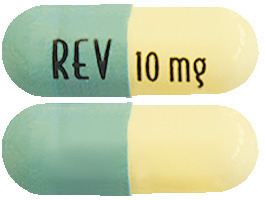
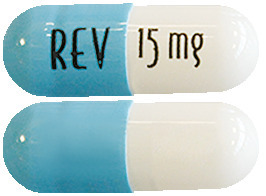
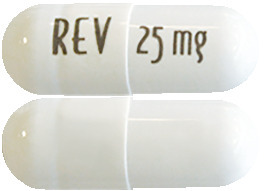
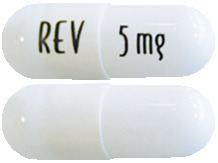



 Recommended dose adjustments for NDMM patients ineligible for transplant receiving Revlimid in combination with dexamethasone are found in Dose adjustments.
Recommended dose adjustments for NDMM patients ineligible for transplant receiving Revlimid in combination with dexamethasone are found in Dose adjustments. Recommended dose adjustments for NDMM post-transplant patients receiving Revlimid maintenance are found in Dose adjustments.
Recommended dose adjustments for NDMM post-transplant patients receiving Revlimid maintenance are found in Dose adjustments. Recommended dose adjustments for previously treated MM patients are found in Dose adjustments.
Recommended dose adjustments for previously treated MM patients are found in Dose adjustments. Recommended dose adjustments for MDS patients are found in Dose adjustments.
Recommended dose adjustments for MDS patients are found in Dose adjustments. Recommended dose adjustments for MCL patients are found in Dose adjustments.
Recommended dose adjustments for MCL patients are found in Dose adjustments. After initiation of Revlimid therapy, subsequent Revlimid dose modifications should be based on individual patient treatment tolerance. Patients with impaired renal function should be monitored for signs and symptoms of neutropenia or thrombocytopenia as per the recommendations (see Section 4.4 Special Warnings and Precautions for Use).
After initiation of Revlimid therapy, subsequent Revlimid dose modifications should be based on individual patient treatment tolerance. Patients with impaired renal function should be monitored for signs and symptoms of neutropenia or thrombocytopenia as per the recommendations (see Section 4.4 Special Warnings and Precautions for Use).


 If the dose of Revlimid was reduced for a haematologic dose-limiting toxicity (DLT), the dose of Revlimid may be re-increased to the next higher dose level (up to the starting dose) at the discretion of the treating physician if continued Revlimid/dexamethasone (Rev/dex) therapy resulted in improved bone marrow function (no DLT for at least 2 consecutive cycles and an ANC ≥ 1.5 x 109/L with a platelet count ≥ 100 x 109/L at the beginning of a new cycle at the current dose level).
If the dose of Revlimid was reduced for a haematologic dose-limiting toxicity (DLT), the dose of Revlimid may be re-increased to the next higher dose level (up to the starting dose) at the discretion of the treating physician if continued Revlimid/dexamethasone (Rev/dex) therapy resulted in improved bone marrow function (no DLT for at least 2 consecutive cycles and an ANC ≥ 1.5 x 109/L with a platelet count ≥ 100 x 109/L at the beginning of a new cycle at the current dose level).







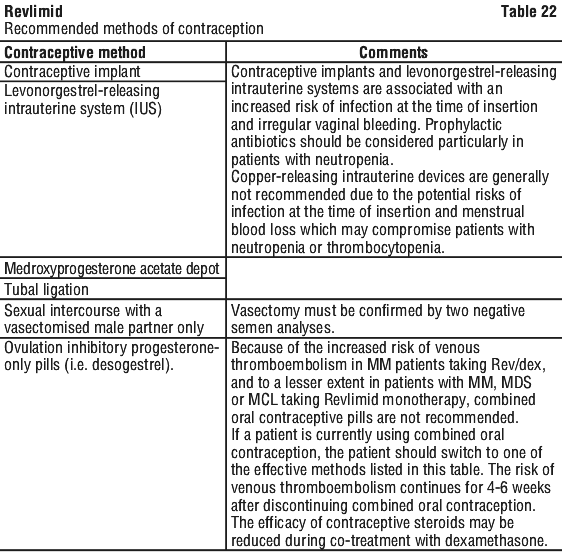

 The following SAEs were also noted in both studies - lung infection, infection, urinary tract infection, herpes zoster and myelodysplastic syndrome.
The following SAEs were also noted in both studies - lung infection, infection, urinary tract infection, herpes zoster and myelodysplastic syndrome.
 The safety results (N = 148) from the phase 2 open label study MDS-003 are consistent with the findings from MDS-004. Neutropenia (66.2%) and thrombocytopenia (64.9%) were the most frequently reported AEs, followed by diarrhoea (60.1%), pruritus (44.6%), fatigue (42.6%), rash (37.8%) and arthralgia (31.8%).
The safety results (N = 148) from the phase 2 open label study MDS-003 are consistent with the findings from MDS-004. Neutropenia (66.2%) and thrombocytopenia (64.9%) were the most frequently reported AEs, followed by diarrhoea (60.1%), pruritus (44.6%), fatigue (42.6%), rash (37.8%) and arthralgia (31.8%).

 The primary efficacy endpoint in the study was progression free survival (PFS). The demographics and disease-related baseline characteristics of the patients were similar across the two treatment groups and reflected a broad NDMM patient population. In total 523 patients were enrolled into the study, with 263 patients randomised to Rbd and 260 patients randomised to Rd, 162 (30.9%) subjects were stratified as "no intent to transplant at disease progression", 81 subjects in the Rbd arm and 81 subjects in the Rd arm.
The primary efficacy endpoint in the study was progression free survival (PFS). The demographics and disease-related baseline characteristics of the patients were similar across the two treatment groups and reflected a broad NDMM patient population. In total 523 patients were enrolled into the study, with 263 patients randomised to Rbd and 260 patients randomised to Rd, 162 (30.9%) subjects were stratified as "no intent to transplant at disease progression", 81 subjects in the Rbd arm and 81 subjects in the Rd arm.


 Study IFM 2005-02 recruited patients aged < 65 years at diagnosis who had undergone treatment with high-dose chemotherapy supported by ASCT and had achieved at least a stable disease response at the time of haematologic recovery.
Study IFM 2005-02 recruited patients aged < 65 years at diagnosis who had undergone treatment with high-dose chemotherapy supported by ASCT and had achieved at least a stable disease response at the time of haematologic recovery. The efficacy of Revlimid maintenance versus placebo/no maintenance as a treatment for adult NDMM patients who have undergone ASCT, as measured by overall survival (OS), was further assessed in a meta-analysis of 3 randomised controlled trials (including Studies CALGB 100104, IFM 2005-02 and GIMEMA). A total of 1209 patients are included in the meta-analysis. The demographic and disease characteristics were reflective of a typical transplant-eligible patient population with NDMM.
The efficacy of Revlimid maintenance versus placebo/no maintenance as a treatment for adult NDMM patients who have undergone ASCT, as measured by overall survival (OS), was further assessed in a meta-analysis of 3 randomised controlled trials (including Studies CALGB 100104, IFM 2005-02 and GIMEMA). A total of 1209 patients are included in the meta-analysis. The demographic and disease characteristics were reflective of a typical transplant-eligible patient population with NDMM.




